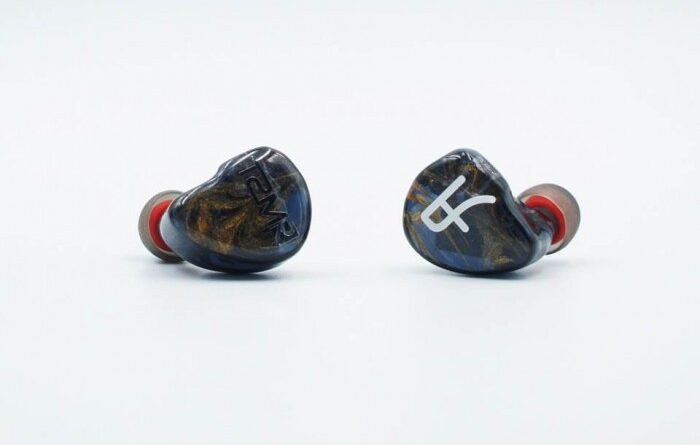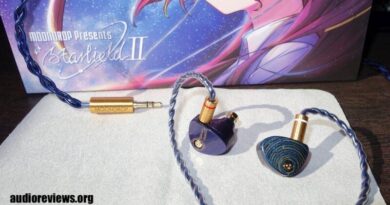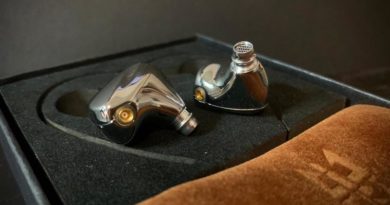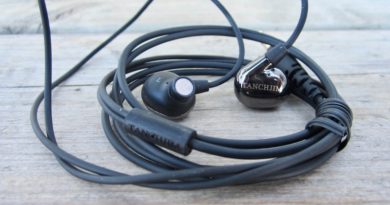Tansio Mirai TSMR-6 Review – Shiny Glass Cannon
I recently had the opportunity to audition one pair of Tansio Mirai TSMR-6 IEMs, which – I anticipate – I did like quite a lot from the technical standpoint, although their presentation is not my cup of tea as they say.
We are talking about quite interesting IEMs, priced just above $500 and featuring a 3 DIP-switch mechanism allowing the user to fine-tune the presentation – up to a certain extent of course: SW-1 enchances midbass, SW-2 enhances mids and vocals, SW-3 apply a (further) boost to trebles. In the end I found myself preferring all 3 switches “ON”, as the presentation gets a bit more musical this way. Read on for more, considering that wherever not specified my notes refer to ON-ON-ON setup.
In this Article
At-a-glance Card
| PROs | CONs |
| A very well executed bright-clear presentation | Overly fast bass transients, some more body required down there |
| Vivid, sparkly, detailed trebles | Difficult to pair due to low impedance and high sensitivity |
| Authoritary, clean, organic mids | Capricious about eartips both on sound and physical grounds |
| Very good technicalities | |
| DIP-switch based tuning customisation system |
Full Device Card
Test setup
Sources: Apogee Groove + Burson FUN + IEMatch / Apogee Groove + iBasso T3 / Sony NW-A55 mrWalkman / Questyle QP1R – Sedna Earfit Light Short tips – Linsoul 4 Core Pure Copper cable – lossless 16-24/44.1-192 FLAC tracks.
Signature analysis
| Tonality | Timbre is lean and clean. Tonality is obviously bright-clear, with very well calibrated and unshrilling trebles and good, articulated and natural mids and highmids. |
| Sub-Bass | Sub-bass is light, although not fully rolled off. With SW-1 ON there is some very modes addition to rumble which is anyhow limited at all times |
| Mid Bass | Midbass is shamelessly 100% BA-style: superfast, lean, modestly punchy. Definitely lean even for my jazz-sided tastes with SW-1 on the 0 position, I keep SW-1 ON to get at least some body in the mid-bass, and even so the presentation is definitely sided in favour of mid-treble lovers. |
| Mids | TSMR-6 mids are the other star of the show here, together with trebles. Left free from any interference or veiling coming from the bass, mids come out authoritatively and in very good quality. Power is a stronger as we go, and the extreme high mids may become too hot for some; on the opposite end low mids are not recessed at all. If the source is competent enough, no or very limited glaring comes out from up there in spite of all that clarity and detail. Turning SW-2 ON does not simply add accent to the mids, it does add some more body too, which is a very welcome addition in my books. |
| Male Vocals | Male vocals are very nice, most of all organic, realistic, quite well textured although free of any added butter (like all the rest) |
| Female Vocals | Females are extremely good, also very organic like males, and at times even more bodied and almost flutey. Higher registers only sometimes risk to scant into too hot territory losing realism |
| Highs | TSRM-6 trebles are superbly clear, sparkly and detailed. Evidently tamed above 10K I presume to avoid “exaggerating” here, which would surely be the case given how much vividness and air is already delivered in the presence section. |
Technicalities
| Soundstage | TSMR-6 offers a very wide stage, with good height and above average depth. |
| Imaging | Helped by great clarity and high end note definition, imaging is just about perfect at all times |
| Details | High mids and trebles deliver a huge amount of detail and microdetail, without scanting into excessive, fatiguing thinness. Not the same happens down low where the bass-dedicated BA is kept too fast. |
| Instrument separation | Separation just great as imaging. Layering is also very good, just some range compression can be spotted at times, consequence of transients kepts on the too snappy end. Liking this or not is of course 100% a matter of preferences. |
| Driveability | TSMR-6 are not easy to properly drive with their low (15 Ω) impedance and very high sensitivity. Most budget (and quite a few non budget) sources will un-naturally either bump their bass up, or produce hiss, or both. If the source is powerful enough, this is one of those many instances where an IEMatch, on Ultra position, proves invaluable. |
Physicals
| Build | Medical grade resin, offered with aesthetic customisation options. Each housing carries a block of 3 DIP switches allowing for signature finetuning: flipping each one ON adds a boost to bass, mids and trebles, respectively. Nozzles are long and quite thick, making a few common eartips e.g. final E and some sednas unfit for TSMR-6. Furthermore, no “lip” is present to help retain eartips in position, just the plastic surface is matte, offering “some” grip, so on the opposite end eartips with stem a tad wider then wanted are also a difficult go. |
| Fit | Extremely easy to fit them, once you go through the pain of pairing the “right” tips – which may be a double issue do to how the nozzles are constructed (see above). My end preference goes to Symbio Peel silicon tips, helping on bass delivery, avoiding to overdo on trebles and “gripping” the nozzle more than appropriately in the back end |
| Comfort | Once finally tip-fitted, comfort is near-perfect at least in my case |
| Isolation | Isolation is not the best I ever experience but definitely above average, also depending on tip selection |
| Cable | I tried the TSRM-6 with the upgrade cable they came with, a well made Linsoul 4 Core Pure Copper. No information about their stock cable. |
Specifications (declared)
| Housing | Medical grade resin, offered with aesthetic customisation options. Each housing carries a block of 3 DIP switches allowing for signature finetuning: flipping each one ON adds a boost to bass, mids and trebles, respectively. |
| Driver(s) | 2 independent Knowles 29689, 2 composite Sonion 33AJP007I, 2 composite Sonion 33AJ007I/9 drivers, 3-way crossover, 2 tubes |
| Connector | 2-pin 0.78mm |
| Cable | N/A (assessed a privately owned unit) |
| Sensitivity | 115 dB |
| Impedance | 15 Ω |
| Frequency Range | 20 – 20000 Hz |
| Package & accessories | N/A (assessed a privately owned unit) |
| MSRP at this post time | $529,00 |
More about switch-based tuning
Product literature is slightly misleading in simply tagging the 3 switches as respectively acting on bass, mids and trebles.
More precisely SW-1 applies an obvious flat horizontal push up to all bass (mid and sub). SW-3 essentially does the same with trebles. SW-2 is different: it leaves central mids where they are, but enhances lowmids and midbass, and makes highmids a bit hotter.
As for my tastes I wanted to make bass more bodied, I started of course by turning up SW-1 and -2, but I found that this way highmids get too hot and most of all too evident, somehow even “stealing the scene” to trebles. Simply put, for how odd it may seem without trying, I found that flipping all 3 switches on I could get more bass as I wanted, while keeping the highmid+treble section still “strong”, even stronger than before but not “unbalanced”.
Conclusions
Even in its ON-ON-ON (aka “1-2-3”, as product literature calls that) configuration, TSMR-6 definitely fall into the clear / analythical drivers category, offering wonderfully clean stage, superb imaging, a very technical ultralean bass and loads of articulated macro and fine micro details from the mids up. So-called “treble-heads” rejoyce: these are for you.
Musicality is kept on a second priority here, at least for my tastes that is, although an exception is worth mentioning regarding vocals, which are delivered in a quite organic an realistic way.
As mentioned at the beginning, this TSMR-6 sample I auditioned for a few days is privately owned, not offered as a review/loaner unit by the manufacturer nor any distributor.
Our generic standard disclaimer.









